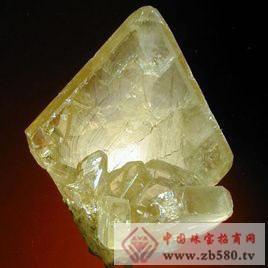Barite is the most common mineral of earthworms and its composition is barium sulfate. Produced in low-temperature hydrothermal veins, such as quartz-barite veins, fluorite-barite veins, etc., often associated with galena, sphalerite, chalcopyrite, cinnabar and so on. The barite deposits produced in Hunan, Guangxi, Qinghai and Jiangxi in China are mostly large hydrothermal single mineral veins. Barite can also be produced in sedimentary rocks and appears as tuberculosis. It is mostly found in sedimentary manganese deposits and shallow sea argillaceous and sandy sedimentary rocks. In the residual clay cover of the weathered residual deposit, it is often knotted and massive.
Chemical composition: BaO: 65.7%, SO3: 34.3%. There are Sr, Pb and Ca isomorphisms in the composition.
The crystals of the barite have a large tubular shape, and the crystals are gathered together to form a rose-shaped or bifurcated ingot, which is called a crown-like barite. Pure barite is colorless and transparent, generally white, light yellow, with a glass luster. Moreover, barite can be used as a white pigment (commonly known as lithopone), and can also be used in chemical, paper, textile fillers, which can act as a flux and increase the brightness of the glass in glass production. But the most important thing is to use it as a weighting agent in the drilling industry and to refine it.

Structural properties
The barite is a non-metallic mineral product containing barium sulfate (BaSO4) as the main component. The pure barite is white and shiny. It is often gray, light red, light yellow, etc. due to the influence of impurities and impurities. Quite good barite can also appear as a transparent crystal. Barite is a sulfate mineral. The composition is BaSO4. The most widely distributed strontium-containing mineral in nature. It can be replaced by a complete analogy of the same type, forming a lapis lazuli; replaced by lead, forming a Beitou stone (named after the birth of Beitou Hot Spring in Taiwan). Orthogonal (oblique) crystal system, the crystal is often thick plate. Pure barite is transparent and colorless, generally white, light yellow, glass luster, and the cleavage surface is pearly. Complete and medium cleavage in 3 directions, Mohs hardness 3 to 3.5, specific gravity 4.5. It is mainly formed under medium and low temperature hydrothermal conditions.
Barite is chemically stable, insoluble in water and hydrochloric acid, non-magnetic and toxic. The chemical composition of barite is Ba[SO4], and the crystal belongs to the orthorhombic (orthorhombic) crystal system of sulfate minerals. It is often thick plate or columnar crystal, mostly dense block or plate-like, granular aggregate. It is colorless and transparent when it is pure. It is dyed into various colors when it contains impurities. The streaks are white, the glass is shiny, and the transparency is translucent. The three sets of cleavage are complete and the angle is equal to or close to 90°. Mohs hardness 3-3.5, specific gravity 4.0-4.6. Identification features: plate crystal, hardness, complete cleavage near the right angle, high density, no sputum in the case of hydrochloric acid, and thus distinguished from similar calcite. The barite is a non-metallic mineral product containing barium sulfate (BaSO4) as the main component. The pure barite is white and shiny. It is often gray, light red, light yellow, etc. due to the influence of impurities and impurities. Quite good barite can also appear as a transparent crystal. Barite is a mixture.
NANJING BOVOTO INTERNATIONAL TRADE LIMITED COMPANY , https://www.jannybb.com